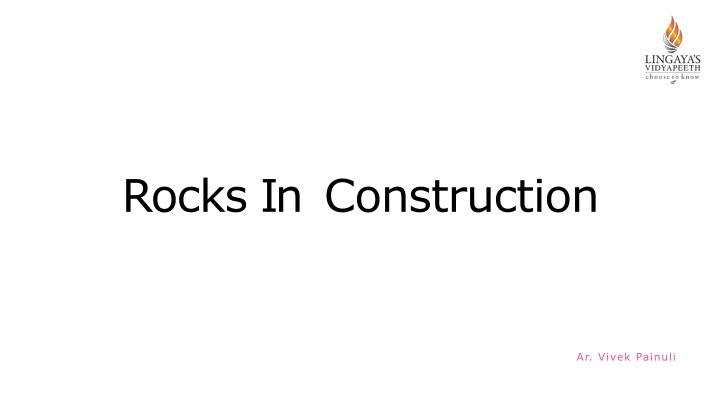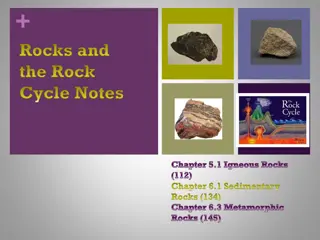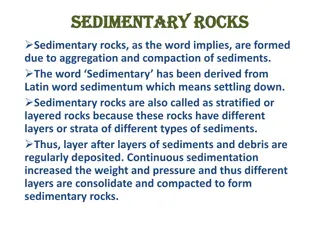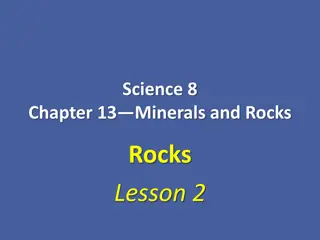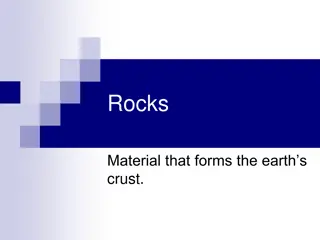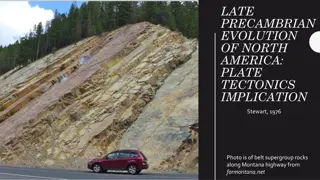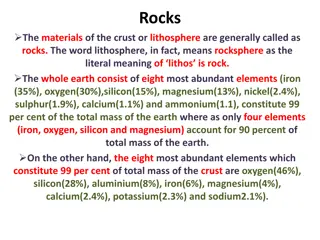Importance of Rocks in Construction and Building Materials
Rocks play a crucial role in construction as geological materials for foundations and building structures. They are classified into igneous, sedimentary, and metamorphic categories based on their composition and properties. Traditional stone masonry is being replaced by modern techniques like stone cladding due to cost and labor intensiveness. Understanding the different types of rocks, such as igneous and sedimentary, is essential for their practical applications in construction.
Download Presentation

Please find below an Image/Link to download the presentation.
The content on the website is provided AS IS for your information and personal use only. It may not be sold, licensed, or shared on other websites without obtaining consent from the author.If you encounter any issues during the download, it is possible that the publisher has removed the file from their server.
You are allowed to download the files provided on this website for personal or commercial use, subject to the condition that they are used lawfully. All files are the property of their respective owners.
The content on the website is provided AS IS for your information and personal use only. It may not be sold, licensed, or shared on other websites without obtaining consent from the author.
E N D
Presentation Transcript
Rocks In Construction Ar. Vivek Painuli
outlines Types Applications Importance
Introduction A rock isa solid cumulative of minerals located in the earth's lithosphere. Rocks are generally classified into igneous, sedimentary and metamorphic rocks. Rocks consist of mixtures of minerals, fragments of other rocks and organic matter. These are classified on the basis of their mineral, chemical and textural composition. Rocks are essentially mixtures and therefore it isnot possible to determine detailed physical and chemicalproperties.
Introduction Rocks are extremely important in terms of their properties of stability and strength as a geological material on which construction foundations are made and historically as building material from which important and monumental buildings are made. Stone used for wall ,building, and bridge construction over historyuntil recent timesisgenerally cut from natural rocks. The building stones are normally extracted by surface quarrying, drilled and split using diamond saws or iron wedges, and then shaped and polished according to theirrequirements.
Introduction Traditional stone masonry israrelyused today, because stone isexpensive to quarry, cut and transport, and the building process is labour and skill- intensive. Instead, most modern stonework utilisesa veneer of stone ( thin, flat pieces ) glued againsta wallof concrete blocks. Thisisknown as veneered stone or stone cladding. Over the years an advantage of stone made from durable rock isthat it is sustainable. Over time constructions have collapsed or fallen into disuse because of wars natural disasters, or economic considerations. The stone wallshave then become available for construction of other local buildings, or bridges.
Igneous Rocks Igneous rocks are created when molten magma cools down and issplit into two main types. T hese are mainlyplutonic and volcanic rocks. The upper 10 miles of the earth's crust comprises almost entirely of igneous rocks. Plutonic or intrusiverocks come into being when magma cools and crystallizes gradually within the earth'scrust. Granite isa typical plutonic rock. Volcanic or extrusive rocks results from magma reaching the surface either as lava or as fragmental missiles. Basalt and pumice are examples of volcanic / extrusive rocks. There are more than 700 types of igneousrocks. The two important factors used for the classification of igneous rocks are the particle size,and the mineral composition of the rock.
Sedimentary Rocks Sedimentary rock formation results from the sedimentation of material in the earth's surface and within collectionsof water . They are extensive in their spread over the earth's crust, covering 70%to 80%of the land area, but they comprise only about 5%of the earth's total crust. The study of sedimentary rock provides much information as to the evolution of life on earth. Sedimentaryrocksalone can contain fossils. strata, referred to as bedding. or biochemical. Limestone and sandstone are examples of clastic formations. Sedimentaryrocksare deposited in layersas in Sedimentary rocks are classified as clastic, chemical precipitate T hey also are important sourcesof coal,drinking water and fossilfuels. related activities are based on the geotechnic properties of sedimentary rock. Many construction-
Sedimentary Rocks Sedimentary rock can be mechanically formed from materials (gravels, sand, silt and clay) suspended in flowing water. T he suspended materialsare then deposited and consolidated. mechanically formed sedimentary rocks are of three types: Rudaceous rocks which isthe cementing together of boulders, for example, conglomerate. T he Arenaceousrocksfor example sandstone, Argillaceousrockswhich clay rocksfor example shale Organically formed Sedimentary rock consists of accumulated animals and plants remains. These include Calcarious rocks, lime stone Carbonaceous rocks, coal Chemically formed sedimentary rocks are formed by precipitation and accumulation of soluble constituents. These include Carbonate rocks, Limestone, dolomite, Sulphate rocks, Gypsum, Chloride rocks, salt.
Metamorphic Rocks Metamorphic rocks form when rocks undergo metamorphosis/changes due to heat and pressure. Igneous and sedimentary rocks mainly undergo this change and become metamorphic rocks. Gneiss, marble, slate, schist and quartzite are some of the different types of metamorphic rocks. T he major typesof metamorphismare contact and regional. The former takes place when magma isinjected into the surrounding solid rocks while, the latter isprimarilyassociated with large masses of rock spread over a very wide area. Thisregional metamorphosis iscaused mainly by temperature and pressure.
Application of rocks to construction.. There are huge variations within each of these rock types, caused by specific mineralogy and geology conditions, and while any stone can be used for building, they each have constraints that make them more or less suitable for different purposes. Granite, sandstone and limestone can all be used for building walls, but slate is only suitable for roofs and floors. Some types of granite can contain mineral salts that cause spalling, where the outer face of stone falls off; slate can contain harmful minerals that break down on exposure to the atmosphere causing stone damage; and sandstone can be too porous and fragile for load- bearing structures. An knowledge of the rock material isrequired to understand how it can be used in a building, what itslimitationsare, and how it will weather over time.
Application of rocks to Geotechnics /Foundations.. The factors that are important when considering erection structures on rock foundations are listed below ..Faults,joints,stratigraphy ..Ground Water levels, springs, surface water, or other effects of ground-water regime. ..Potential cavities due to mines ,tunnels and other caves etc. ..Potential problems due to dissolving , swellin, and/or erosion ..Potential rock slope instability. ..Utilityservice lines e.g gas water ,sewage etc.
Application of rocks to Geotechnics /Foundations.. Itismost important when considering a rock site for construction that detailed information is available on the localand adjacent areas. Often there is is significant information available on the local ground geology from national ground survey organisationssuch asthe British Geological Survey. (BGS). geotechncial reports should be based on obtaining detailed local information using boreholes. Infact the BGS (see linkbelow) provides stores data on completed boreholes, mines, underwater springs,wells etc. The rock structure isan important consideration for geotechnics an the following factors are very important. Note the factors are each listed from best condition to worst T he preliminary
Application of rocks to Geotechnics /Foundations.. ..T hicknessof Bedding. -Massive:1m thick or greater . -T hick bedded: beds from 0,2 to 1m thick. -Medium bedded: beds from 100mm to 300mm thick. -T hin bedded: 100mm. thick or less. ...Degree of Fracturing (Jointing). -Unfractured:fracture spacing -2m or more. -Slightlyfractured: fracture spacing -0,6m to 2m. -Moderately fractured: fracture spacing -200mm to 600mm. -Highlyfractured: fracture spacing -50mm. to 200mm. -Intensely fractured: fracture spacing -50mm. or less. ..Dip of Bed or Fracture. -Flat:0to 20 degrees. -Dipping:20 to 45 degrees. -Steeply dipping:45 to 90 degrees
ImportanceOfUsage Inorder to carry out civil engineering projects safely and successfully, such as constructing road, bridges, tunnels. T anks, reservoirsand buildings, selection of site isimportant from the viewpoint of stability of foundation and availability of construction materials, geology of area isimportant and rock-forming region, their physical nature, permeability, faults, joints etc. Thus geology isrelated to civil engineering in construction jobs with economy and success. Geology provides a systematic knowledge of construction material, their structure and properties. The knowledge of erosion, transportation and deposition by surface water helps in soil conservation,rivercontrol,coastaland harborworks.
ImportanceOfUsage Thefoundationproblemsofdams,bridgesand buildingsaredirectly relatedwithtogeologyoftheareawheretheyaretobe built. Geologicalmapsand sectionshelpconsiderablyinplanningmany engineering projects. Igneousrocks,granite,basalt,gabbroand themostimportant speciesusedinthebestwayto carrybig weightsuchasroad construction. Metamorphic rocks,marble,gneissand schistcolumnisnotsuitable asmaterialforroad constructionbecause itisweakinbearingpressuremeansthebreak. Sedimentaryrocks,limestone,sandstone and claystoneused
